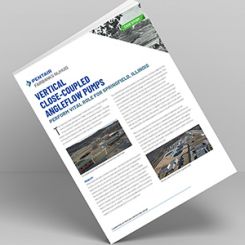Q. What symptoms are typical indicators of an inefficient pumping system?
A. Many pumping system components are not dynamic. That is, these components allow fluid or heat transfer but, aside from thermal expansion or structural vibration, do not move and do not have dynamic surfaces that wear out. The most common types of problems in these components are leakage, fouling, valve failure and cracks in pipe supports.
For many industrial facilities, the energy consumed in pumping fluids comprises a large fraction of the facility's overall electricity usage. Operators of pumping systems often are not aware of how effectively the energy required to pump the fluids is being used. If they are unable to meet their functional requirements, a large part of the plant, even the entire facility, may be affected.
A few symptoms in pumping systems often indicate if improper sizing, selection, operation or other issues affect the system's performance. They are:
- Systems in which valves are throttled to regulate flow rate, level, pressure, etc.
- Systems that employ bypass (recirculation) flow regulation
- Systems that involve a batch-type process, but one or more pumps operate continuously
- Frequent on/off cycling of a pump in a continuous process
- Presence of cavitation noise either at the pump or elsewhere in the system
- An equipment procurement policy based solely on lowest bid price
- A multiple, parallel pump system in which the same number of pumps are always in operation
- A pumping system that has undergone a change in function (for example, a system that formerly provided cooling water to eight plant heat exchangers, two of which are no longer in service), but with no change in pump equipment or operation
- A pumping system with no flow, pressure or power indication (akin to driving a car with no speedometer, gas gauge or other critical indicators)
The existence of any one of these symptoms does not guarantee significant savings potential, but it indicates a greater likelihood of achieving savings. The more symptoms present, the greater the likelihood of potential energy savings.
Q. Are there any computer tools available to help analyze pumping efficiency in systems?
A. Optimizing Pumping Systems: A Guide for Improved Energy Efficiency, Reliability, & Performance, the book referenced in the first question, has a list of 26 tools. Some provide a free download, and others are commercially available. Two that you may freely download include:
Pumping System Assessment Tool, which is available from:
Department of Energy
Industrial Technologies Program (ITP)
Room 5F-065, MS EE-2F
1000 Independence Ave, SW
Washington, DC 20585
800.342.5363
www1.eere.energy.gov/industry/bestpractices/software.html
The Pumping System Assessment Tool (PSAT) helps industrial users assess the efficiency of pumping system operations. PSAT and its accompanying valve tool support data measurements in either English or metric units. PSAT uses achievable pump performance data from HI standards and motor performance data from the MotorMaster+ database to calculate potential energy and associated cost savings. The tool also enables users to save and retrieve log files, default values and system curves for sharing analyses with other users. It is available for free download after registering on HI's Free Stuff Page.
Pump System Improvement Modeling Tool (PSIM), which is available from:
Hydraulic Institute
Pump Systems Matter
6 Campus Drive
1st Floor North
Parsippany, NJ 07054
973-267-9700
Website
(Education/tools)
Pump System Improvement Modeling Tool (PSIM) is a free educational tool focused on helping end users better understand the hydraulic behavior of pumping systems. With the challenges of today's marketplace, fluid handling systems must be both cost effective and energy efficient. It is essential that users evaluate the total pump system in their designs. PSIM models systems with up to 12 pipe runs. It is available for free download, after registering on HI's Free Stuff Page.
Q. Where can I obtain detailed information on improving the efficiency and reliability of pumping systems?
A. Pump Systems Matter and the Hydraulic Institute (HI) have published a book on this subject titled Optimizing Pumping Systems: A Guide for Improved Energy Efficiency, Reliability, & Performance, available from www.Pumps.org.
Pumping systems are used throughout the world to transport water and other fluids and in the operation of most industrial processes. Commercial and residential buildings also rely on pumps for heating and cooling, fire protection and other functions. Pumping systems account for nearly 25 percent of the energy consumed by electric motors and for 20 to 60 percent of the total electrical energy usage in many industrial, water and wastewater treatment facilities. Fortunately, economically feasible opportunities exist to make industrial pumping systems more efficient, allowing for reduced energy costs, lower operating and maintenance expenses and enhanced profitability.
The initial purchase and installation cost of a new pumping system is typically a small part of the total cost to operate a system over its life, which can be more than 15 to 20 years, depending on the application. It is the routine operating costs of energy, maintenance and other recurring expenses that are the primary components of the total lifetime cost. Therefore, optimum efficiency in designing and operating pumping systems is in the best interest of all facilities.
However, the importance of pumping systems in the daily operation of facilities promotes the practice of over-sizing pumps to ensure that the needs of the system will be met under all conditions. This practice, unfortunately, often leads to inefficient operation, resulting in unnecessarily high energy and maintenance costs.

